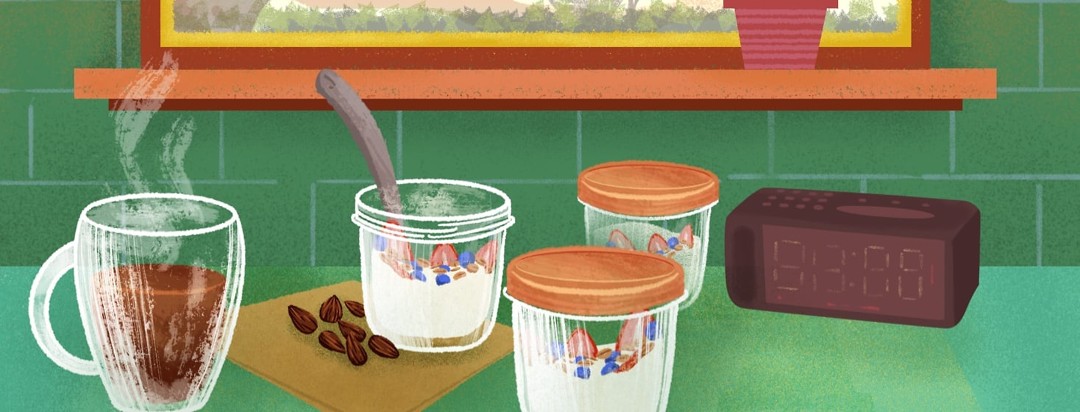Breakfast: Start the Day with Type 2 Diabetes Meal Prep
Skipping breakfast is not a good idea when you have type 2 diabetes. Studies show that skipping breakfast can lead to higher blood glucose levels during the rest of the day, regardless of how little you eat later.1 And yet, eating a healthy breakfast every morning can be challenging.
Mornings can be chaotic. Who has time to cook a meal while getting yourself and the family up and out the door? And many of the prepared breakfast foods (like cereal, fruit-flavored yogurt, and pastry) are carb-heavy and light on protein. Some people just don’t find eating a meal first thing in the morning appealing or appetizing. Yet they shouldn’t wait until lunch to eat something substantial or their blood glucose levels will be adversely affected.
What to do? Try meal prepping your breakfast for better type 2 diabetes management. Meal prep will make it easier to eat a breakfast that sets you up with a nutritious start to the day and keeps your blood glucose levels lower at lunch and dinner.
The basic meal prep breakfast recipe
Meal prep is a two-step process that most people get done in a couple of hours once a week. With meal prep you:
- Prepare up to a week’s worth of a meals in advance.
- Store those meals in single-serving portions.
Meal prep can save you time and energy on meal preparation. And, more importantly, it makes it easier to consistently eat healthy meals that support managing type 2 diabetes. For breakfast, the basic recipe for a healthy meal is: lean protein + complex carbohydrates + healthy fat.2
Breakfast meal prep ideas
When preparing breakfast, start with a protein and build from there. Among the most popular proteins for breakfast are eggs, plain Greek yogurt, and breakfast meats. Here are a few ideas to get you started.
Eggs
The simple egg is a protein powerhouse that can be prepared in many ways that are portable.
- Egg salad. Chop boiled eggs, add mayonnaise, and your favorite seasonings. Serve with seed crackers and some berries for crunch and sweetness.
- Crustless quiche in silicone muffin cups. Add chopped vegetables and/or breakfast meat to the egg mixture and you have a tasty combination.
- A protein box around boiled eggs. Put a couple of boiled eggs with string cheese, grape tomatoes, baby carrots, and whole-grain crackers and you have a combo that rivals anything you’ll find in a coffee shop.
Plain Greek yogurt
Greek yogurt has fewer carbohydrates than regular yogurt. Start with plain Greek yogurt and add whatever you choose.
- Add what you like best. This can be nuts and seeds, or fruit, or a sugar-free flavoring like vanilla. If you choose to add a sweetener, like monk fruit or stevia, use what works best for your blood glucose management.
- Yogurt parfait. Add fruit and oats, chia seeds, or low-carb granola. Because oats and granola can get waterlogged, parfaits are best assembled right before eating. Portion out the ingredients you want each in their own container so they’re ready to go. When you sit down to eat put them together and enjoy.
Breakfast meats
- Stir fry cut sausage with veggies. Choose whatever veggies you like to go along with flavorful sausage medallions. Be sure to drain off excess fat before portioning. This is the kind of dish best served when it can be heated up before eating. A minute or so in the microwave should do the trick.
- Wrap veggies in slices of meat. Let your imagination go and come up with the combinations you like best. It could be asparagus wrapped in thinly sliced ham or dill pickle spears wrapped in roast beef. You might want to pack some seeded mustard for dipping with that last one.
Tips for breakfast meal prep with type 2 diabetes
Try to apply these tips to your breakfast meal prep:
Use on-the-go options
If eating breakfast first thing in the morning isn’t appealing, think grab-and-go. Not everyone is ready to eat first thing. Having a healthy meal ready to go makes it easier to eat once hunger hits and say “No, thank you” to less healthy options.
Mix it up
Add some variety so you don’t get bored. Prepare at least two different kinds of meals for the week. Vary the ingredients so you’re not eating the same thing all the time. One way you can do this by not using the same vegetables in every cup of your baked quiche. Or use different fruit on different days.
Make your own bread products
Try baking low-carb bread or biscuits if you miss having baked products at breakfast. These low-carb recipes often use an alternative to wheat flour, like almond or coconut flour, and alternative sweeteners in place of sugar, honey, or molasses.
Track carbs and portion size
If you use bread or other baked goods be mindful of the carb count and portion size. Sometimes you just want to have some toast. When you meal prep you have the opportunity to be choosy and make sure any bread or baked goods you put in your meal match what works best for you in terms of carb counts, glycemic load, and/or ingredients.
Meal prep breakfast for a healthy start to your day
Starting your day with breakfast puts you on the path toward better management of your type 2 diabetes. Using meal prep can give you a head start toward making this easier to do consistently.

Join the conversation